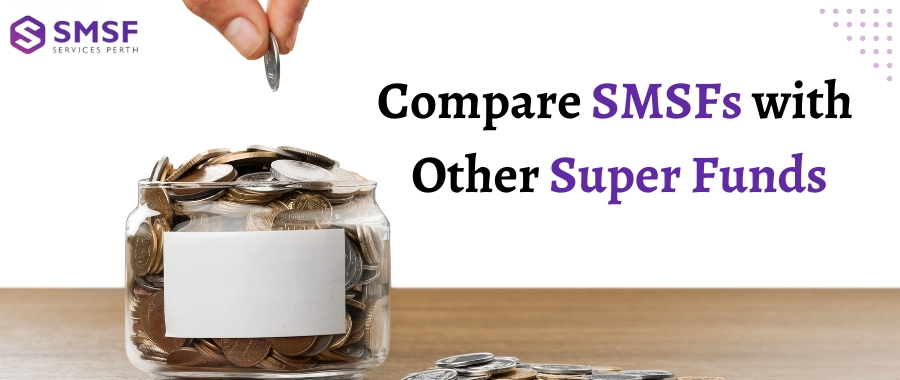
When planning for retirement, choosing the right superannuation fund is critical. Two popular choices are Self-Managed Super Funds (SMSF) and other superannuation funds.
Before comparing superannuation funds in Australia, it is necessary to understand the differences.
One of the significant differences between SMSFs and other superannuation funds is the level of control and flexibility. With an SMSF, the members have control over their fund’s investment decisions, whereas different superannuation funds have limited options for investment and often have pre-determined investment options.
Understanding SMSF and Other Superannuation Funds
To compare super funds Australia 2023, we have a few key features to understand the difference between SMSF and other superannuation.
| Superannuation Funds | Key Features |
| SMSF | – Controlled and managed themselves.
– costs are higher but offer more control over expenses. – SMSF gives you greater control over your investment choices. – SMSFs require knowledge and expertise in managing investments and compliance. |
| Other Superannuation Funds | – Managed by professional fund managers.
– lower fee but less control over investment expenses. – Other funds may limit investment choices due to their structure, but they offer access to diverse options. – Other super funds minimise the need for specialist investment knowledge and have experienced professionals managing them. |
What are Superannuation Funds in Australia?
One of the benefits of superannuation funds is that they offer tax advantages, making them an attractive investment option for many Australians. The Australian government ensures that they are well-managed and invested responsibly and ethically.
Self-Managed Super Funds (SMSFs) are superannuation funds managed by themselves rather than by professional fund managers. The Australian Taxation Office (ATO) manages SMSFs their members are responsible for ensuring compliance with all legal and regulatory requirements.
In Australia, superannuation funds are an increasingly important investment vehicle to secure their retirement. These funds pool money from individual contributors and invest in diverse assets, such as stocks and bonds. Many Australians rely on superannuation funds for a significant portion of their retirement income.
However, not all superannuation funds are created equal, and individuals need to research and choose funds that fit their financial goals and risk tolerance. To know the difference between the best superannuation comparison in Australia with the average superannuation funds, individuals need to be familiar with the different superannuation funds.
What are the different Types of Superannuation Funds?
For superannuation funds in Australia, there are several types to choose from. These include industry funds, retail funds, and corporate funds.

Industry Funds
These are not-for-profit funds associated with a particular industry, such as construction, hospitality, or healthcare. Trustee boards of employer and employee representatives generally offer low fees and a range of investment options. If we compare SMSF vs industry funds, the industry funds tend to offer lower fees and a range of investment options.
Retail Funds
Retail funds are another option for individuals looking to invest in their retirement. However, they can also have higher fees and lower investment returns due to their selection of investment options. It is essential for individuals to carefully consider the pros and cons of retail funds before deciding if they are the best fit for their retirement goals.
Corporate Funds
Corporate funds can be an attractive option for individuals who want more control over their investment choices and are willing to pay slightly higher fees for tailored investment options. While corporate funds can also be industry or retail funds, they often charge lower fees and offer investment options.
What Changed in Superannuation in May 2023?
In May 2023, the landscape of superannuation underwent significant changes. One of the changes was the increase in the minimum contribution rate, which had been held steady for several years prior. Additionally, the government introduced a new tax bracket for high-income earners contributing to their super, ensuring a fairer distribution of tax benefits.
The Australian Taxation Office (ATO) will have increased powers to monitor and enforce superannuation laws
From 1 July 2023, the ATO will have increased authority to monitor and implement superannuation laws.
- Issue administrative directions to trustees
- Require trustees to provide information and documents
- Freeze superannuation accounts
- Prohibit trustees from making certain decisions
- Disqualify trustees from holding office
- Pursue civil penalties against trustees and other persons who breach superannuation laws.
Compare SMSFs with other Super Funds
1. Fee
Fees charged by SMSFs can vary depending on the provider and the investments you choose. It is essential to understand the costs when running an SMSF, including administration, investment, and audit fees. Other superannuation funds also charge fees, which may be hard to compare.
2. Investment Options
While SMSFs offer more investment options and control, this also means more responsibility and risk. Other superannuation funds often have pre-determined investment options. SMSF pension plans in Perth can be complex, so seek professional advice before making investment decisions.
3. Taxation
SMSFs offer tax benefits, particularly capital gains tax and estate planning. However, there are strict rules and regulations to comply with. SMSF tax return costs can also be higher due to the complexity of the tax system and reporting requirements. While additional costs associated with Self Managed Super Fund tax returns, the potential benefits in tax savings and control over investments make it a worthwhile consideration.
4. Compliance and Regulation Requirements
SMSFs have higher compliance and regulation requirements, meaning more time and effort to manage and maintain. Other superannuation funds involve professional fund managers who handle all compliance and regulation requirements for members.
5. Performance
Performance is a consideration when comparing SMSFs with other superannuation funds. SMSFs often outperform superannuation funds, but this is not always the case, and it depends on investment choices and market conditions. Super performance comparison Australian super funds are available on the Australian Government website. It will help you to compare the performance of various SMSFs and other superannuation funds.
6. Risks and Considerations
Switching from one superannuation fund to another requires careful consideration of the risks and costs involved. It is necessary to seek professional advice before making decisions that could impact your financial future.
Ultimately, choosing between SMSF and other superannuation funds comes down to your financial circumstances, investment goals, and risk tolerance. Seek advice from an Expert SMSF Specialist Advisor or another financial professional to help you make the best decision for your situation.
SMSF vs Other Superannuation Funds: Which is the Best Option for Your Superannuation?
- The super fund industry offers a hands-off approach for those less interested in accountability and more interested in limited investment options. Self-Managed Super Funds (SMSFs) deliver greater control and flexibility with greater responsibility and regulatory requirements.
- When making this decision, it’s necessary to consider factors such as fees, investment options, insurance and protection, compliance and regulation, control and responsibility, performance and returns, and estate planning and succession.
- Seeking expert advice from SMSF consultants in Perth or other financial advisors can help you make a well-informed decision. They can guide you through the complex regulatory requirements of SMSF management services in Perth and help you evaluate other superannuation fund options.
How to Transfer My Super to Another Fund?
The process of transferring your super is relatively simple. Contact your new fund and request a transfer form. Once you’ve completed the form and returned it to your new fund, they will take care of the rest.
One option is to roll your existing superannuation balance into a new account with a lower fee structure or better investment options. Before proceeding with a transfer, assess the fees associated with the current and potential new accounts and the investment performance.
Also Read: Seven steps to setting up a self-managed super fund
Conclusion
Choosing between SMSF and other superannuation funds is a decision that requires careful consideration. SMSF offers greater control and flexibility, responsibilities, and costs. On the other hand, superannuation funds come with lower costs and less administrative work, but they may not provide investment options and control.
To find the best self-managed super fund, evaluate different factors, including investment options, costs, returns, compliance, and administration.
Whether you choose SMSF or other superannuation funds, seek the advice of professional SMSF specialist advisors, expert estate planners in Perth, and consultants to ensure that you make well-informed decisions. It is necessary to regularly review your superannuation account to ensure that it aligns with your long-term financial objectives and remains relevant to your changing needs.